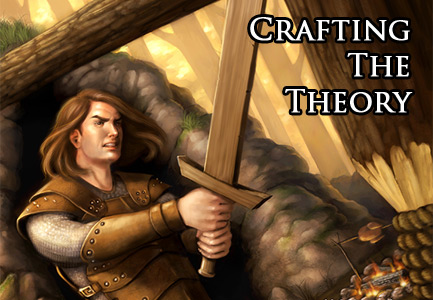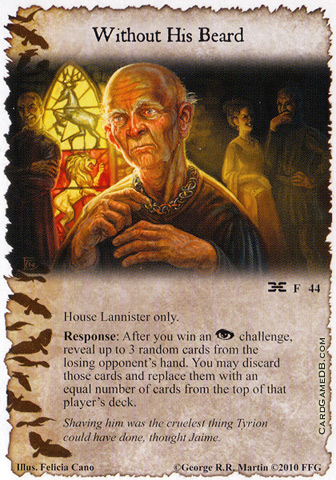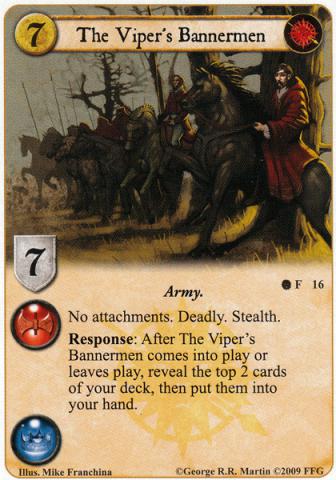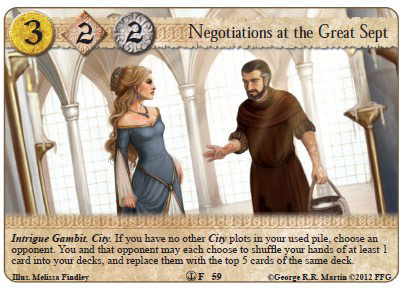Welcome to Card Game DB
Register now to gain access to all of our features. Once registered and logged in, you will be able to create topics, post replies to existing threads, give reputation to your fellow members, get your own private messenger, post status updates, manage your profile and so much more. If you already have an account, login here - otherwise create an account for free today!
Register now to gain access to all of our features. Once registered and logged in, you will be able to create topics, post replies to existing threads, give reputation to your fellow members, get your own private messenger, post status updates, manage your profile and so much more. If you already have an account, login here - otherwise create an account for free today!
Crafting the Theory - Card Advantage
Jun 14 2013 05:05 AM |
Ire
in Game of Thrones
Small Council Crafting the Theory Ire After a long hiatus, we (Kennon, Ire and WWDrakey) are bringing the Crafting the Theory Article-series back to CardGameDB. The aim of the series has always been ‘to discuss and dissect the theory behind AGoT’, and our current environment is one that could benefit from such a theoretical approach. We will be taking turns writing the articles, and will start off today with Ire’s look at Card Advantage and how it shapes the competitive environment, past present and future.
After a long hiatus, we (Kennon, Ire and WWDrakey) are bringing the Crafting the Theory Article-series back to CardGameDB. The aim of the series has always been ‘to discuss and dissect the theory behind AGoT’, and our current environment is one that could benefit from such a theoretical approach. We will be taking turns writing the articles, and will start off today with Ire’s look at Card Advantage and how it shapes the competitive environment, past present and future.Card Advantage
In this first article we want to talk about something that has defined the metagame for years, but has perhaps finally reached that problematic point at which it may break the camel’s back. Card advantage.
Firstly we should define the term card advantage, so that we have a clear and concrete basis for our analysis.
Definitions
Card advantage essentially refers to playing cards with effects that allow you to gain an advantage in the number of cards that you have at your disposal, be it in play, in hand or in Shadows.
The most concrete types of cards for providing Card Advantage are:
- A card which takes more than 1 card away from your opponents hand (Kings of Winter (TWoW)).
- A card which gives you more than 1 draw/reveal/search either immediately or in a longer period (Golden Tooth Mines (Core) and The Viper's Bannermen (PotS) are classic examples).
- A card that gives you more than 1 card back from the dead/discard pile (think Dale Seaworth (AToTT)).
- A card that removes more than 1 card from your opponents side of the table (The Hatchlings' Feast (ASitD) on a Threat from the North (PotS) turn.)
- Exchange - A card effect by which both players lose 1 card (classic examples would be No Quarter (TBC) or Paper Shield (QoD)). By definition, an exchange does not provide any kind of Card Advantage, but often very real situational or board advantage.
- Cantrip - A card that both has a temporary or permanent effect and replaces itself with another card when played. Cantrips usually don’t provide Card Advantage, but rather situational or board advantage without causing you to lose cards.... However, there are some exceptions that are quite unique to AGoT. These would be cantripping attachments (R'hllor's Blessing (AKitN) - providing you with both a permanent attachment and a card) and cantripping removal (Poisoned Coin (THoBaW) - removal and a self-replacement).
- On legs - A card which both functions as an effect and a character. In the case of removal on legs, like Ser Jorah Mormont (WLL) or Newly Made Lord (TftH), these provide Card Advantage.
- Card Disadvantage - There are also some clear card disadvantage cards, which swing the card count in your opponent’s favor, in exchange for some kind of board or situational advantage. A classic example of a good card disadvantage card would be Much and More (AHM), while a classic example of a bad one would be Without His Beard (CbtC).

So the basic point is that you have access to more cards than your opponent does, which usually increases your choices and allows you to gain better board position. It can be also used as an easy indicator on who is ahead in the game.
You could say that card advantage in Thrones has always been an important (perhaps even the most important) part of the game. However, we do have something unique which other card games lack - plots. Plots bring a new aspect to the whole equation. When it comes to card advantage claim matters, as do when revealed effects (especially removal or draw/search). With claim it is possible to gain card advantage through successful Military and Intrigue challenges. The higher the claim, the more advantage you will gain with the challenge win. Remember, that with plot cards you are not losing a card so... everything you can gain out of a plot is free from a card advantage perspective.
History
Since card advantage has always been tied closely to being ahead in the game and having more choices on what to do, it has also always been chained to what has been looked as a T1 build.
For any given T1 build there have nearly always been strong points of card advantage:
Seasons - Kings of Summer (ASoS), Kings of Winter (TWoW), Samwell Tarly (TRS)
Hyperkneel - Golden Tooth Mines (Core), Pyromancer's Cache (TWot5K), Tommen Baratheon (SA).
Widlings/NW - Val (RotO) + Dolorous Edd (TWH).
Brotherhood - Flea Bottom Scavenger (AToT)
Maesters - The Maester's Path (GotC), Tin Link (CbtC) and Valyrian Steel Link (HtS)
KotHH - The Hatchlings' Feast (ASitD), The Prince's Plans (TIoR), The Viper's Bannermen (PotS), Aegon's Hill (TTotH)...

So, it's probably quite easy to convince everybody that the builds that the community has perceived to be "T1 viable" have always had a very strong element of card advantage in them.
Now, this has always been either a problem, or 'feature' of competitive AGoT... but there has never been much talk about it in the community, as it is not been seen as a problem. So why would it be a problem? Well, mainly because the theme with the strongest draw support is usually the top dog to be defeated. This has always tended to leave a large percentage of cards to be buried as binder fodder (or for casual play like with so many other card games).
Now, the real problem here is that this has not happened because of their own worth or efficiency, but rather the efficiency of any connected card advantage engines. Themes will rise and fall based on the efficiency of their engine, not on how good the cards themselves are, or how nice synergy they provide. If the engine doesn’t work, you’ll never even draw into the required parts to get that synergy going in the first place.
There has also been another trend with card advantage in AGoT, mainly that it has favored slower deck types. This means that the top decks have nearly always been Control. Now, there are some exceptions like Wildlings which were able to go Aggro with Val, and Martell Maesters were a hard to disrupt Rush which got its card advantage from The Maester's Path (GotC).
With Control, players were used to the fact that once they managed to gain a steady supply of card advantage - they would win. That's after all the real 'motto' of competitive AGoT: "Draw = win". The best example of this would probably be some Martell KotHH builds that were played around a year ago. The whole point of the deck was keeping card advantage... and then going for an alpha strike turn with To the Spears! (PotS), once the overall card domination was secured.
So it could be said that the meta has always been defined by the idea of card advantage, but it has also restrained itself with it. Only deck types with strong card advantage support were ever really Tier-1 competitive.
Fast forward to the current day
With The Long Voyage (TPoL) entering the game in Pirates of Lys, the whole game changed. With it, we can throw many of the the old truths out of the window. Most themes (that don’t require an Agenda) now have access to card advantage. Control can be challenged in card advantage and especially in card quality, and thus they can no longer sit on top of their hand and win by the simple virtue of having card advantage. Sounds good, so why is this a problem?
Now that everyone has access to draw it is actually easier to see the more problematic aspects inherent in AGoT with respect to card advantage. More cards simply means more everything. More resources in the form of non-Limited locations, more events to push for temporary advantage, more characters to play out... When you control card advantage you control the flow of the whole game.
Many other games have some kind of built-in limitations on how much use you can get out of card advantage. Netrunner functions more around resources and has a hand limit, Call of Cthulhu sets an almost unbreakable limit to the number of ‘paid’ actions you can perform in one round, MTG has both a hand limit and a limitation on how much resources you can play in one round, while even Legend of the Five Rings has both a built-in limiter to how many locations/characters you can play and a maximum hand-size.
In AGoT, there are no such inherent limiters. Instead, we have a lot of ‘free’ effects (most events), plenty of 0 cost cards and even a decent amount of resource locations that provide an effect immediately. The only limits we have are the draw cap (which can be bypassed in many ways) and plot resets, which penalize on overcommitting. They do not penalize on having more cards, but rather using them unwisely. To make matters worse, the resets tend to function more in the direction of emphasizing the importance of card advantage, instead of limiting it.
Now, back to the matter of The Long Voyage. With other competitive decks their ‘bad games’ usually happen when they cannot gain card advantage early on or have a poor setup, and they are usually hard pressed to recover from such a beginning against another competitive deck. With TLV this rule tends to have been changed. Thanks to the automatic added draw from the agenda, the decks can stay competitive even when they get off to a bad start or have a lousy setup. Which seems kind of unintuitive, since added variance should be the downside of the agenda. TLV is in a way 'self-repairing' when it comes to its downside. So the agenda is a lot more consistent... even when it shouldn't be, by virtue of it's drawback.
Negotiations at the Great Sept (TPoL) is also a part of the problem, since it is actually gaining you card advantage in two forms. It is both giving cards (outside of the draw cap) and it has 2 claim, which we already touched on having an effect as a kind of card advantage.

These new infusions of card advantage into the metagame have also had another side-effect. As we have gained access to more T1-T1.5 decks for the first time (due to more easily available efficient card advantage engines), we have also widened the gap in comparison to existing decks without a card advantage engine (unless they run TLV). The gap between competitive and noncompetitive decks has actually widened. Now, if you don't have card advantage tools, you can be sure that your deck cannot hold up well against the top ones, and since there are a wider range of viable T1 builds, "going rogue" (aka teching against the meta) isn't nearly as viable as an option anymore. In a way, we’ve gotten a very wide competitive Tier 1-1.5, with a huge gap to Tier-2 and lower.
Looking to the Future
Draw (and especially card advantage outside of the draw cap) as a mechanic might be too powerful and game defining in AGoT from a purely mechanical standpoint, as we can see in the past and current trends of the metagame.
We've now gotten some spoilers from the upcoming Kingsroad Cycle, in the form of Jaime Lannister, which would take us back to the more 'traditional' form of vulnerable card advantage. It might be possible that the design is switching back in that direction, but on the other hand, just in this cycle alone we received two strong card advantage agendas in The Long Voyage and Black Sails. So we cannot be sure where the card advantage trend is actually going from here. We have also seen new winter agenda which punishes card hoarding, but rewards spending... which might be really problematic if we still have TLV on top.
Should we get rid of TLV and NatGS? Possibly, but with that we are again going back to that old problematic ground of restricting viable tournament decks to the ones with the most powerful draw support. Also if we get completely rid of these tools, then we will go back to the old Control mindset of winning only thanks to having superior card advantage.
Too good reducers? One reason why TLV decks manage to be on top is that the games 0 cost reducers allow players to easily dump their hand on the board. In these cases, the problems come in the form of reducers that give resource advantage straight away. Now these have never before been really a problem (due to draw requiring more commitment and being harder to come by) so it could be said that the problem is more on the side of card advantage and the powerful resources are just helping it do its dirty work.
Now, there's something really interesting also arriving in the Kingsroad Cycle: the "Cards at your command" mechanic. Now this mechanic will be a good start for punishing decks for 'too good' card advantage, and also for pushing decks more towards quality over numbers. It is left to see if it is enough to balance the old card advantage power structure, but it could definitely be a start.
The three primary directions for the game to traverse in:
- More good card advantage engines for everybody. Once every single deck/theme starts consistently gaining 3-4 cards per round, the impact from card advantage starts to get weaker.
- Constantly limiting, restricting and banning the strongest card advantage engines. Looking at the restricted list, it’s not far-fetched to say that this has been the approach in the game for a long while now.
- Adding more cards for decks to combat card advantage with, be they penalizing you for having more ‘cards at your command’ or locking effects like Stannis Baratheon. A splash of unreliability/risk would do wonders for making card advantage more of a decision, instead of an automatic optimization point.
Where do you think we should go from here? Let us know in the comments below.
- Zaidkw, bigfomlof, JCWamma and 7 others like this



 Sign In
Sign In Create Account
Create Account











8 Comments
It may come to the point where something needs to be done. But I suggest waiting for 2 reasons:
1) We are in the middle of tournament season, and the only reason I would see to act on a card that people are using, and have already used, is if it was completely causing NPE. I personally do not see that here.
2) There is, as stated in the article, a new cycle coming out that may already have built in ways to either deal with it or make it less attractive of an option.
Just my thoughts...
http://www.cardgamed...sure-your-deck/
some of the early blogs are actually well written (not as well as this, great work Ire) and could be useful to you snagga.
You write like a dream, Ser!